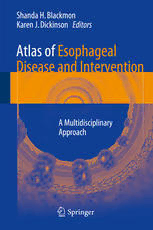
Atlas of Esophageal Disease and Intervention: A Multidisciplinary Approach PDF
Preview Atlas of Esophageal Disease and Intervention: A Multidisciplinary Approach
Shanda H. Blackmon Karen J. Dickinson Editors Atlas of Esophageal Disease and Intervention A Multidisciplinary Approach 123 Atlas of Esophageal Disease and Intervention Shanda H. Blackmon (cid:129) Karen J. Dickinson Editors Atlas of Esophageal Disease and Intervention A Multidisciplinary Approach Editors Shanda H. Blackmon, MD, MPH, FACS Karen J. Dickinson, MBBS, BSc, MD, FRCS Associate Professor Division of General Thoracic Surgery Division of General Thoracic Surgery Mayo Clinic Mayo Clinic Rochester , MN Rochester , MN USA USA ISBN 978-1-4939-3087-6 ISBN 978-1-4939-3088-3 (eBook) DOI 10.1007/978-1-4939-3088-3 Library of Congress Control Number: 2015954726 Springer New York Heidelberg Dordrecht London © Springer Science+Business Media New York 2015 T his work is subject to copyright. All rights are reserved by the Publisher, whether the whole or part of the material is concerned, specifi cally the rights of translation, reprinting, reuse of illustrations, recitation, broadcasting, reproduction on microfi lms or in any other physical way, and transmission or information storage and retrieval, electronic adaptation, computer software, or by similar or dissimilar methodology now known or hereafter developed. T he use of general descriptive names, registered names, trademarks, service marks, etc. in this publication does not imply, even in the absence of a specifi c statement, that such names are exempt from the relevant protective laws and regulations and therefore free for general use. T he publisher, the authors and the editors are safe to assume that the advice and information in this book are believed to be true and accurate at the date of publication. Neither the publisher nor the authors or the editors give a warranty, express or implied, with respect to the material contained herein or for any errors or omissions that may have been made. Printed on acid-free paper Springer Science+Business Media LLC New York is part of Springer Science+Business Media (www.springer.com) This book is dedicated to my husband, Matt Blackmon, my partners in practice, and my esophageal support group; for the years of dedication, support, and love. Without such teams, caring for these patients would be impossible. Pref ace T his atlas began when I was in my fi rst year of clinical practice. As I began to develop my skills in endoluminal technology, I realized there was no single resource to guide me. There were several moments through these years when it became clear that one specialty may not always understand important facts from another specialty regarding the disease they both treat. I distinctly remember speaking to a patient after an esophagectomy for cancer and having the patient tell me his gastroenterolo- gist told him I may have resected the vagal nerve, thus giving him a dumping s yndrome. I responded by stating “I certainly hope I resected it, because that is part of the surgery!” I started a multidisciplinary tumor board to enhance learning and communication between the specialties, focusing on the diseases rather than keep- ing it specialty-specifi c. I made every attempt to learn all aspects of caring for patients with esophageal disease. T his book is meant to be a single reference for anyone caring for patients with esophageal disease. When separate specialties learn to think like the other, patients benefi t. Surgery today is becoming less invasive and more endoluminal. Most p rocedures I perform today were not performed when I was a resident 10 years ago. Learning new technology is diffi cult especially when the new skill requires a specialist to move toward another specialty or “cross a line.” A common language, understanding, philosophy, and terminology can enhance communication, thus improving patient care. Rochester, MN, USA Shanda H. Blackmon, MD, MPH, FACS vii Acknowledgments T hanks to Blythe Gorman, MD; Puja Guar, MD; and Min P. Kim, MD, for their contributions. T hanks to Mary Schwartz, MD, Professor of Pathology, Weill Cornell Medical College, Houston Methodist Hospital, Houston, TX. Thanks to Dr. K. R. Shen, Division of General Thoracic Surgery, Mayo Clinic, Rochester, MN, USA, for the colonic reconstruction fi gures and images. Thanks to Dr. Michael Klebuc, Centre for Facial Paralysis and Functional Restoration, Houston Methodist Hospital, Houston, TX, for Figure 10.25d. T hanks to Dr. Stephen, W. Trenkner, Department of Radiology, Mayo Clinic. Rochester, MN, for the radiological images of eosinophilic esophagitis. Thanks to Dr. Louis M. Wong Kee Song, Department of Gastroenterology and Hepatology, Mayo Clinic, Rochester, MN, for the endoscopic images of esophageal perforation treated with Ovesco clips. Thanks to Dr. Jane Matsumoto, Dr. Joel Fletcher and Dr. Jonathan Morris, Department of Radiology, Mayo Clinic, Rochester MN for their help with planning and printing 3-D models of the esophagus and surrounding anatomy, and for their help with the text pertaining to this in the Radiology chapter. ix
